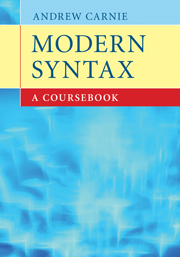Book contents
- Frontmatter
- Contents
- Acknowledgments
- How to use this book
- A note on the theoretical perspective of this book
- 1 Some basic ideas in syntax
- 2 Categories and subcategories
- 3 Constituents, MERGE and trees
- 4 Movement and control
- 5 Conclusions
- Appendix 1 Glossary, symbols and abbreviations
- Appendix 2 Features and their values
- Appendix 3 Rules, constraints and principles
- References
- Index
4 - Movement and control
Published online by Cambridge University Press: 05 June 2012
- Frontmatter
- Contents
- Acknowledgments
- How to use this book
- A note on the theoretical perspective of this book
- 1 Some basic ideas in syntax
- 2 Categories and subcategories
- 3 Constituents, MERGE and trees
- 4 Movement and control
- 5 Conclusions
- Appendix 1 Glossary, symbols and abbreviations
- Appendix 2 Features and their values
- Appendix 3 Rules, constraints and principles
- References
- Index
Summary
PASSIVES
Objectives:
Review the identification of passives vs. actives.
Look at the feature structure of the passive auxiliary bepassive.
Figure out why the doers of actions appear to be optional in passives.
Determine the feature structure for the preposition byagent.
Draw the trees for the passive sentences.
Review
Comment Recall from unit 9 our discussion of voice. Voice refers to the perspective on the action. Active sentences highlight the doer of an action, passive sentences have the item that is acted upon as the subject of the sentence. Consider:
(1) (a) Calvin ate the beef waffles. active
(b) The beef waffles were eaten (by Calvin). passive
In an active sentence, the doer of the sentence (Calvin) appears in the subject (first) position and the thing acted upon (the beef waffles) appears in the object position. Recall that in English, the passive voice is marked with a be auxiliary and the participial form of the verb: The beef waffles were eaten. The formula for a passive is be + participle (contrast this with the perfect, where the participle is combined with the verb have). Active sentences bear no special marking.
- Type
- Chapter
- Information
- Modern SyntaxA Coursebook, pp. 229 - 316Publisher: Cambridge University PressPrint publication year: 2011



